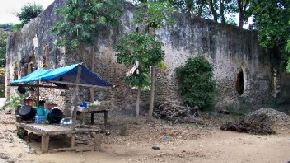| |
274 Moluccas, Kisar
Homnon (sarong)
|
| Locale: | Probably Meher (Kisar speaking) people. |
| Period: | Circa 1950 |
| Panels: | 2 |
| Design: | Homnon for woman of the nobility, with characteristic Oirata patterning with large kota lama (the square blocks) and coloration, in which red predominates. Patola-inspired floral patterns in the two wider bands. Four narrower bands with different small motifs that end in small tumpal motifs. Other than the Oirata cloths, Meher cloths typically do not have anthropomorphic or zoomorphic motifs. Numerous narrow stripes with dotted lines. Two wide bands near the extremities in solid near-black, achieved by overdying morinda with indigo. The rectangular boxes represent kota lama, the old Dutch fortress Delfhshaven. |
| Size: | 63.5 x 138 cm (25 x 54.3 in) |
| Weight: | 650 g (371 g/m2) |
| Yarn: | Cotton, hand-spun, medium - plus accent stripes in commercial cotton� |
| Comment: | [To be elaborated.] Intricate patterning tightly executed. The work of a master weaver. Blue weft. Ex collection J.B. Lüth. |
| Background: | Additional information in chapters on Moluccas and Kisar. |
| Sources: | The rectangular blocks subdivided into six small blocks such as those on on the left side of the widest ikat band and near the right hand side are very similar to those shown in Jasper and Pirngadie, Inlandsche Kunstnijverheid in Nederlandsch IndiŽ, Deel II, Weefkunst, Plaat 26F and on Fig. 236. The large lozenges are similar to motif shown on Plaat 27 and on Fig. 237. Very similar to 19th to early 20th C. homnon in Metropolitan Museum of Art, Nr. 1988.104.72, but longer and younger. Photo below shows the remains of small fortress Delfshaven, kota lama.
 |
| |
 ©Peter ten Hoopen, 2025
All rights reserved.
|


